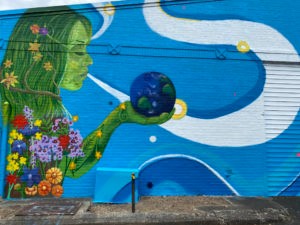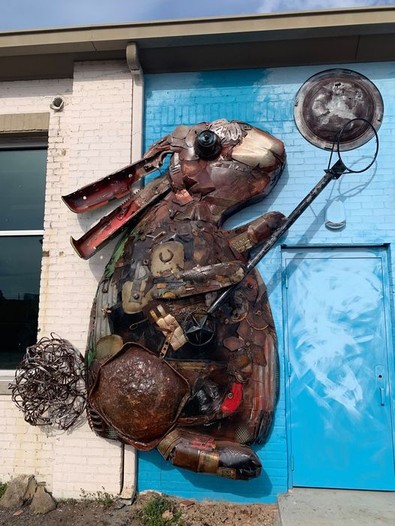City Municipal Garage and the Innovation Barn
Introduction
Author-Uploaded Audio
Listen to a narration of this entry's description by UNCC Urban Institute User.
Text-to-speech Audio
Images
Structure before renovation

Mural at Innovation Barn

Scrap metal bunny at Innovation Barn

Backstory and Context
Text-to-speech Audio
The facility was designed with motor vehicles in mind, backing up to the Seaboard Railway line so that gasoline, motor oil and related products could be brought in by tank car. The Municipal Garage likely also held the city’s dwindling number of work horses in its early years. The Observer noted that former City Stable, located at Hill and Poplar Streets where Panthers’ Stadium is today, closed around 1928, when the new Municipal Garage opened. The building is slated to reopen in Spring of 2021 as the Innovation Barn. The effort is a partnership between the City of Charlotte and Envision Charlotte with a goal of operating within the Circular Economy Principles in which resource usage and waste are minimized, preventing materials from getting into our landfills. This can be achieved through changing the design of products, business models, and supply chains. Charlotte is committed to becoming the first circular city in the United States, and the development of the Innovation Barn is one of the first priorities in implementing the city’s circular strategy.
A cafe and retail space will be open, as well as business incubator space for entrepreneurs focused on upcycling - the process of turning discarded materials like plastic bottles into usable products like clothing or shoes. An aquaponic garden stocked with plants and fish will be on site, as well as a soldier fly composting facility capable of processing over 1 ton of food and organic waste per week.
Continue east on Otts Street to find the last medallion at the corner of Louise Avenue.
As you walk along the Innovation Barn, you will see a 10-foot-tall sculpture of a bunny blowing bubbles. The bunny is constructed of a patchwork of scrap metal to promote upcycling and is blowing bubbles to promote recycling. Bubble wrap and air pillows for packaging are not recyclable in our weekly pickup, but those materials can be dropped off at the Innovation Barn to correctly enter the recycling stream. The bunny is proudly named Louise Cotton and pays homage to the origins of the neighborhood, which is enduring even if not in its original state, much like the bunny crafted from metal remnants.
